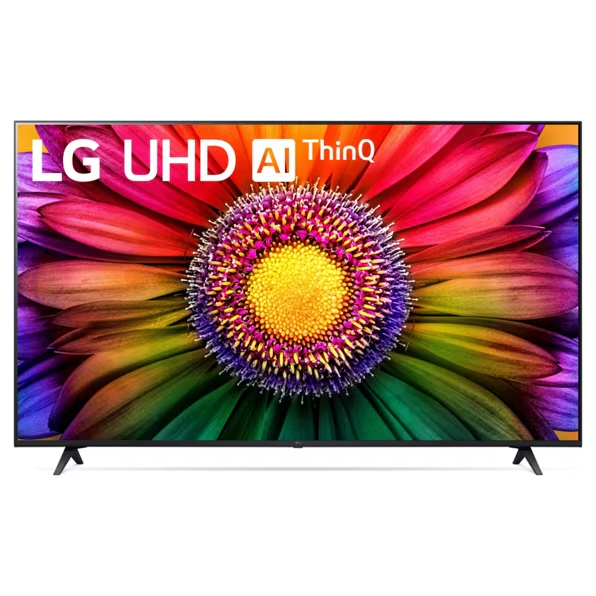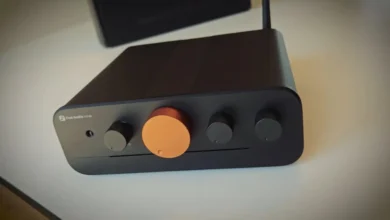Why the LG UR8000 is a Best-Seller: Stunning Crisp HDR & Ultra-Smooth Motion

The LG UR8000 series is part of LG’s 2023 regular 4K TV lineup. The LG UR8000 takes over from the 2022 LG UQ8000 series in full. While the UR8000 is in the lower price range, it doesn’t disappoint in terms of picture quality. Of course, the limitations of the panel’s specifications are a factor.
Firstly, it has a relatively low brightness, not exceeding 300 nits in peaks, and a refresh rate of 50 Hz. In principle, this is enough to understand that we are dealing with an entry-level TV. But like its higher-end counterparts, it uses the webOS 23 operating system with a full set of intelligent functions. In the LG UR8000 55″ 4K HDR review, we will describe the main functionality of the new product.

LG UR8000 review
Design
It’s hard to tell the LG UR8000 LB 4K TV apart from its predecessors, the LG UQ8000 and LG UP8000. The body has the same thickness as typical when using a direct backlight unit. The bezels are still thin, and the only limitation is the small technological bezels on the panel itself. We usually see this kind of design on at least some mid-range models, so it’s nice to see an inexpensive device with such a nice appearance.
You May Like: KEF Q950 Review:
Having unfolded the LG UR8000 TV, we find a rather inexpressive back panel. All the connectors are divided into two groups and are located on the right side, and the power connector is the only one, which is located separately on the left. Their layout is almost the same as last year’s counterparts, and allows for easy wall mounting of the TV.
The plastic V-shaped legs are spaced almost the entire width of the case. They hold it steady, but you need wide furniture for tabletop installation. The cable management system is missing in the lower-end model. The Magic Remote has not changed; its black back panel is still glossy and easily soiled. The remote supports both voice control and an on-screen cursor.
Image quality
All of LG’s basic UHD TVs feature a quad-core processor with limited functionality. As always, details are scant, and the α5 AI Gen6 processor found in the LG UR80 doesn’t give us any indication of its specs beyond some generic marketing material from LG.
Obviously, it is primarily limited by the AI capabilities that we see in the a7 and a9 processors. That is, its AI scaling capabilities are relatively small. But although it is highly dependent on the quality of the source content, image scaling does not reveal any noticeable artifacts and is generally quite satisfactory.
As we noted above, the LG UR8000 TV works with direct LED backlighting placed behind the ADS matrix. The backlighting has much lower capabilities than the mini LED or FALD system, which means much lower output brightness, less precision in backlight control, and lower contrast.
This results in black appearing more grey than true black. And in a dark room, this will be very noticeable. Therefore, as a basis for a home cinema, the LG UR8000 is far from ideal. Models in this series with diagonals of 70 inches and less than 55 inches have VA matrices with much higher contrast (but with worse viewing angles). Another important aspect of an HDR TV is the output brightness.
Typically, its performance in the low-end categories is less than stellar, and in most cases, the brightness capabilities of these devices are not enough to make HDR mode attractive. In the case of the LG UR8000, the Expert (dark room) mode seems to be the most accurate without any calibration. In this mode, the SDR brightness in a 10% window is 280 nits. HDR brightness in the same window increases to 320 nits when using the Cinema mode.
Check Out: Sony HT-S20R review
The LG UR8000 uses an ADS panel, and in addition to good color accuracy, this means wide viewing angles. Yes, these are not the extreme angles of OLED, but horizontally aligned panels (IPS) display images at angles much better than any VA panel. Overall, if you are considering the LG UR8000 for family use or plan to watch from different angles, then you can consider it a good option.
As for HDR support, the LG UR 8000 TV only works with HDR10 (playback of content from media) and HLG (terrestrial television). Dynamic metadata formats, Dolby Vision, and HDR10,+ are not compatible with the series in question.
LG UR8000 Series – Key Specifications
Display & Picture Quality
- Screen Sizes Available: 43″, 50″, 55″, 65″, 70″, 75″, 86″
- Display Type: LED (Direct-lit, IPS/ADS panel for most sizes; VA panel for 70″ and below 55″)
- Resolution: 4K UHD (3840 x 2160)
- Refresh Rate:
- 60Hz (most sizes)
- 120Hz (86″ model only) 9
- HDR Support: HDR10, HLG, HDR10 Pro
- Processor:
- α5 AI Processor Gen6 (43″-75″)
- α7 AI Processor Gen6 (86″) 19
- AI Upscaling: Yes (4K upscaling for lower-resolution content)
- Filmmaker Mode: Yes (preserves original cinematic intent)
- Peak Brightness: ~300 nits (SDR), ~320 nits (HDR) 12
Gaming Features
- Game Optimizer: Yes (centralized settings for gaming)
- ALLM (Auto Low Latency Mode): Yes
- Input Lag: ~10ms (low latency for responsive gaming) 12
- HDMI 2.1 (86″ model only): Supports 4K@120Hz, but no VRR 9
- Cloud Gaming: NVIDIA GeForce Now, Utomik
Smart TV & OS
- Operating System: webOS 23
- Voice Assistants: Amazon Alexa, Google Assistant, LG ThinQ AI
- Streaming Apps: Netflix, Disney+, Prime Video, HBO Max, Apple TV+, YouTube, etc.
- Magic Remote: Included (with NFC, voice control, and motion pointer)
- Sports Alert: Yes (notifications for live games)
Audio
- Speaker System: 2.0 Channel (20W)
- AI Sound Pro: Virtual 5.1.2 surround sound
- Bluetooth Surround Ready: Yes (compatible with wireless speakers/soundbars)
- Audio Codecs: Dolby Digital, AAC, PCM, DTS
Connectivity
- HDMI Ports:
- 4x HDMI (86″) (2x HDMI 2.1, 2x HDMI 2.0, eARC support)
- 3x HDMI (other sizes) (eARC on one port)
- USB Ports: 2x USB 2.0
- Wi-Fi: Wi-Fi 5 (802.11ac)
- Bluetooth: 5.0
- Ethernet: 1x LAN port
Design & Dimensions (65″ Model Example) 3
- Without Stand: 57.2″ (W) x 33″ (H) x 2.3″ (D)
- With Stand: 57.2″ (W) x 35.7″ (H) x 10.6″ (D)
- Weight:
- Without stand: 47.2 lbs
- With stand: 47.8 lbs
- VESA Mount: 300 x 300mm
Power & Energy
- Power Consumption: ~95W (65″ model)
- Standby Power: <0.5W
Additional Features
- ThinQ AI: Smart home integration
- LG Channels: Free live TV & on-demand content
- Anti-Glare Coating: Matte finish for reduced reflections
Key Takeaways
Best For: Budget-friendly 4K TV with solid picture quality, good for movies (dark rooms) and casual gaming.
Limitations: Low peak brightness, no Dolby Vision, poor off-angle viewing, and limited gaming features (except 86″ model).



